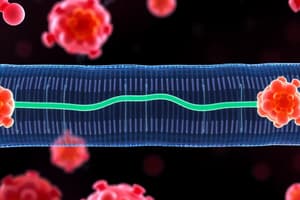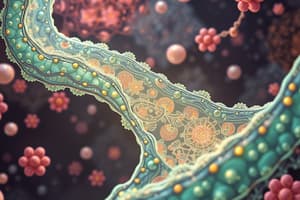Podcast
Questions and Answers
What is the primary role of the plasma membrane in biological cells?
What is the primary role of the plasma membrane in biological cells?
- To provide structural support to the cell
- To store genetic information
- To produce energy for cellular processes
- To regulate the exchange of substances with the interstitial fluid (correct)
Which of the following is NOT a characteristic of the plasma membrane?
Which of the following is NOT a characteristic of the plasma membrane?
- It is selectively permeable
- It is completely impermeable to all substances (correct)
- It allows passive diffusion of certain molecules
- It can facilitate active transport
How do biological cells utilize the plasma membrane for substance exchange?
How do biological cells utilize the plasma membrane for substance exchange?
- By undergoing osmosis only
- By allowing only nutrients to enter while rejecting waste
- Through both passive and active transport mechanisms (correct)
- By permitting all substances to flow freely at all times
What surrounds biological cells, providing them with selective permeability?
What surrounds biological cells, providing them with selective permeability?
What is the interstitial fluid's relationship to the plasma membrane?
What is the interstitial fluid's relationship to the plasma membrane?
What distinguishes selective ion channels from pores?
What distinguishes selective ion channels from pores?
Which of the following correctly describes the role of the narrow region in selective ion channels?
Which of the following correctly describes the role of the narrow region in selective ion channels?
Which type of channel is characterized by its response to changes in membrane voltage?
Which type of channel is characterized by its response to changes in membrane voltage?
Which of the following is NOT a characteristic of pores?
Which of the following is NOT a characteristic of pores?
What is the main evolutionary significance of channels?
What is the main evolutionary significance of channels?
What is the primary factor that affects the rate of diffusion through a membrane?
What is the primary factor that affects the rate of diffusion through a membrane?
Which of the following methods of transport requires energy expenditure?
Which of the following methods of transport requires energy expenditure?
According to Fick's Law, the rate of transport is positively influenced by which of the following?
According to Fick's Law, the rate of transport is positively influenced by which of the following?
What property of substances significantly reduces their permeability through a biological membrane?
What property of substances significantly reduces their permeability through a biological membrane?
If the diffusion coefficient increases, what happens to the rate of transport?
If the diffusion coefficient increases, what happens to the rate of transport?
What is the effect of increasing the molecular weight of a substance on its diffusion through a membrane?
What is the effect of increasing the molecular weight of a substance on its diffusion through a membrane?
What is the primary characteristic of substances that can achieve simple diffusion across a phospholipid bilayer?
What is the primary characteristic of substances that can achieve simple diffusion across a phospholipid bilayer?
Which equation describes the relationship between permeability and the diffusion coefficient?
Which equation describes the relationship between permeability and the diffusion coefficient?
What is the effect of increasing the viscosity of a medium on the diffusion coefficient?
What is the effect of increasing the viscosity of a medium on the diffusion coefficient?
How does the distance of diffusion affect the time required for diffusion?
How does the distance of diffusion affect the time required for diffusion?
What type of substances must utilize selective ion channels to cross a biological membrane?
What type of substances must utilize selective ion channels to cross a biological membrane?
In what scenario would diffusion be most effective?
In what scenario would diffusion be most effective?
What ratio illustrates the permeability of propanol versus glycerol across the membrane?
What ratio illustrates the permeability of propanol versus glycerol across the membrane?
What is the expected outcome if the absolute temperature of the medium is increased?
What is the expected outcome if the absolute temperature of the medium is increased?
Flashcards
Biological systems
Biological systems
Systems composed of cells that perform life functions.
Cells
Cells
The basic structural and functional units of living organisms.
Plasma membrane
Plasma membrane
A selective barrier surrounding the cell, controlling substance exchange.
Selective permeability
Selective permeability
Signup and view all the flashcards
Interstitial fluid
Interstitial fluid
Signup and view all the flashcards
Membrane Channels
Membrane Channels
Signup and view all the flashcards
Integral Proteins
Integral Proteins
Signup and view all the flashcards
Selective Ion Channels
Selective Ion Channels
Signup and view all the flashcards
Pores
Pores
Signup and view all the flashcards
Types of Selective Ion Channels
Types of Selective Ion Channels
Signup and view all the flashcards
Passive Transport
Passive Transport
Signup and view all the flashcards
Simple Diffusion
Simple Diffusion
Signup and view all the flashcards
Flux
Flux
Signup and view all the flashcards
Fick's Law of Diffusion
Fick's Law of Diffusion
Signup and view all the flashcards
Diffusion Coefficient (D)
Diffusion Coefficient (D)
Signup and view all the flashcards
Rate of Transport (RT)
Rate of Transport (RT)
Signup and view all the flashcards
Concentration Gradient
Concentration Gradient
Signup and view all the flashcards
Permeability Coefficient (P)
Permeability Coefficient (P)
Signup and view all the flashcards
Hydration Shell
Hydration Shell
Signup and view all the flashcards
Molecular Weight
Molecular Weight
Signup and view all the flashcards
Active Transport
Active Transport
Signup and view all the flashcards
Osmosis
Osmosis
Signup and view all the flashcards
Endocytosis
Endocytosis
Signup and view all the flashcards
Ion Channels
Ion Channels
Signup and view all the flashcards
Study Notes
Transport in Biological Systems
- All biological systems consist of cells surrounded by a selective plasma membrane.
- This membrane controls the exchange of substances between the cell and its surroundings.
- Various substances like oxygen, carbon dioxide, ions, glucose, amino acids, fatty acids, and more, all have different sizes, shapes, and molecular weights.
Types of Transport
- Passive Transport
- Simple Diffusion: Movement of molecules from high to low concentration, driven by random thermal motion.
- Facilitated Diffusion: Movement of molecules across a membrane with the help of transport proteins, still following the concentration gradient.
- Osmosis: The specific diffusion of water across a selectively permeable membrane.
- Filtration: Movement of substances across a membrane due to pressure differences.
- Active Transport: Movement of molecules against their concentration gradient, requiring energy.
- Primary Active Transport: Directly uses ATP (energy) to move ions against their gradient.
- Secondary Active Transport: The movement of one substance down its concentration gradient drives the movement of another substance against its gradient.
- Endocytosis: The process of capturing a substance or particle from outside the cell by engulfing it within a membrane-bound vesicle.
Diffusion
- Diffusion is a random process of movement of any molecules (solid, liquid, or gas) from one location to another through the random thermal motion.
- The amount of substance crossing a biological membrane per unit time is called flux.
- Net flux always occurs from a region of higher concentration to a region of lower concentration.
- Diffusion rate depends on the substance's molecular weight: heavier molecules diffuse slower.
- Fick's Law of Diffusion describes the relationship between different factors that influence diffusion.
- RT (rate of transport) is proportional to the concentration gradient (C1-C2) across the membrane, the surface area (S) of diffusion, and the diffusion coefficient (D) and inversely proportional to the distance of diffusion (∆x).
Diffusion Coefficient
- The Stokes-Einstein equation describes how the diffusion coefficient (D) is related to variables such as Boltzmann Constant (KB), absolute temperature (T), the molecular radius (r) and the viscosity of the medium (η).
- Molecules progressively spread in space over time, following a square root relationship with time (d=√6Dt).
Diffusion in Biological Systems
- Diffusion limits of space constraints biological activity
- Distance and time scale of diffusion is significant for cellular process
- Typical distance = micrometers, time in seconds to hours.
- Water molecule collisions occur very frequently.
Permeability
- Permeability (P) quantifies how easily a substance passes through a membrane.
- Permeability depends on the substance's diffusion coefficient (D) and its partition coefficient (K). This relationship has a direct correlation between the velocity of a substance (cm/s).
- Substances that are highly soluble in lipids have high permeabilities.
- Water, oxygen, carbon dioxide, and anesthetic gases exhibit high permeability across cell membranes.
Permeability and Molecular Size
- Smaller molecules have higher permeability.
- Larger molecules have lower permeability.
- Biological membranes are more permeable to smaller, nonpolar molecules than to large polar molecules.
Permeability and Polarity
- Nonpolar molecules are more readily permeable than polar molecules across biological membranes.
- Lipid bilayers are more permeable to nonpolar molecules than to polar molecules.
Permeability and Ions
- Cell membranes are generally impermeable to ions due to their charge and hydration shells.
- Specialized ion channels exist to facilitate ion transport.
Simple Diffusion and Channels
- Channels are integral membrane proteins which act as selective pathways allowing controlled transport. Types of channels include selective ion channels, porins, and aquaporins.
- Three main types of selective ion channels:
- Voltage-gated channels
- Ligand-sensitive channels
- Mechanosensitive channels
Aquaporins
- Aquaporins are channel proteins specialized in water transport.
- They are highly specific for water and other small polar solutes.
Studying That Suits You
Use AI to generate personalized quizzes and flashcards to suit your learning preferences.



